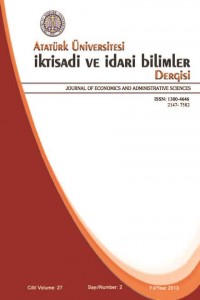Öz
In this study, an econometric analysis was made on the basis of 1994:Q2-2010:Q2 and 2001:Q3-2010:Q2 periods in order to investigate the determinants of external debt in Turkey. According to the obtained empirical evidences, determined that while internal debts as a determinant of external debt have strong influence on external debt in the 1994:Q2-2010:Q2 period, government spending becomes an important factor of external debt in the 2001:Q3-2010:Q2 period.
Anahtar Kelimeler
Kaynakça
- Adıyaman, A. D., (2006), “Dış Borçlarımız ve Ekonomik Etkileri”, Sayıştay Dergisi, 62, Ankara.
- Ajayi, S. I., (1991), “Macroeconomic Approach to External Debt, The Case of Nigeria”, Research Paper Eight, African Economic Research Consortium.
- Cottarelli, C., Krueger, T., Moghadam, R., Perone, P. J., Ruggiero, E. ve Elkan, R., (1998), “Hungary: Economic Policies for Sustainable Growth”, IMF Occasional Paper 159, Washington.
- Dickey, D. and Fuller, W. A. (1979), “Distribution of the Estimates for Autoregressive Time Series with a Unit Root”, Journal of the American Statistical Association, 74, 427-431.
- Edo, S. E., (2002), “The External Debt Problem in Africa: A Comparative Study of Nigeria and Morocco”, African Development Bank Blackwell Publishers, USA.
- Granger, C. W. J. ve Newbold, P. (1974). "Spurious regressions in econometrics". Journal of Econometrics 2, ss.111-120.
- Gujarati, D. N., (2006), Temel Ekonometri, Çev. Ümit Şenesen ve Gülay Göktürk Şenesen, Literatür Yayınclık, İstanbul.
- IMF, (2004), “Jordan: Selected Isssues and Statistical Appendix”, IMF Country Report, 04(121), Washington.
- Iyoha, M. A., (1999), “External Debt and Economic Growth in sub-Saharan African Countires: An Econometric Study”, AERC Research Paper, 90, Nairobi.
- Javed, Z. H. ve Şahinöz, A., (2005), “External Debt: Some Experience from Turkish Economy”, Journal of Applied Sciences, 5(2).
- Karagöz, K., (2007), “Türkiye’de Dış Borçlanmanın Nedenleri Ekonometrik Bir Değerlendirme”, Sayıştay Dergisi, 66-67, Ankara.
- Koyuncu, F. T. ve Tekeli S., (2010), “1990 Sonrası Dönemde Türkiye’de Dış Borç Stoku Üzerinde Etkili Olan Ekonomik Faktörlerin Analizi”, Ekonomi Bilimleri Dergisi, 2(1).
- Lessard, D. R., (1986), “International Financing for Developing Countries”, World Bank Staff Working Papers, 783, Washington, USA. Loganathan, N.,Sukemi, M. N. ve Sanusi, N. A. (2010), “External Debt and Macroeconomics Performance in Malaysia: Sustainable or Not ?”, Global Economy and Financial Journal, 3(2). Malezya.
- Schclarek, A., (2004), “Debt and Economic Growth in Devoloping and Industrial Countries” http://www.aaep.org.ar/espa/anales/resumen04/04/SchclarekA.pdf (Erişim Tarihi: 29.01.2011)
- TCMB (2011) Elektronik Veri Dağıtım Sistemi, İstatistiki Veriler http://evds.tcmb.gov.tr/cbt.html (Erişim Tarihi: 21.04.2011) T.C. Hazine Müsteşarlığı (2011), “Ekonomik ve Borç Göstergeleri Sunumu”, http://www.hazine.gov.tr/irj/go/km/docs/documents/Hazine%20Web/ %C4%B0statistikler/Borc_Gostergeleri_Sunumu/borc_gostergeleri.pd f (Erişim Tarihi: 21.04.2011)
- World Bank (1988), “External Debt, Definiation, Statistical Coverage and Methodology”, Paris. http://www.worldbank.org/ (Erişim Tarihi: 02011)
- Wijeweera, A., Dollery, B. ve Pathberiye, P., (2005), “Economic Growth and External Debt Servicing: A Cointegration Analysis of Sri Lanka, 1952 to 2002”, Working Paper Series in Economics, University of England, School of Economics.
- Yeldan, E., (2004), “Türkiye Ekonomisi’nde Dış Borç Sorunu ve Kalkınma Stratejileri Açısından Analizi”, Çalışma ve Toplum Dergisi, 1, İstanbul.
Öz
Bu çalışmada, Türkiye’de dış borçlanmanın belirleyicileri,
1994:Q2-2010:Q2 ve 2001:Q3-2010:Q2 dönemleri temel alınarak araştırılmıştır.
Elde edilen ampirik kanıtlara göre, 1994:Q2-2010:Q2 döneminde dış
borçlanmanın belirleyicisi olarak iç borçlar güçlü bir etkiye sahipken; 2001:Q3-
2010:Q2 döneminde kamu harcamalarının önemli bir faktör olduğu tespit
edilmiştir.
Anahtar Kelimeler
Kaynakça
- Adıyaman, A. D., (2006), “Dış Borçlarımız ve Ekonomik Etkileri”, Sayıştay Dergisi, 62, Ankara.
- Ajayi, S. I., (1991), “Macroeconomic Approach to External Debt, The Case of Nigeria”, Research Paper Eight, African Economic Research Consortium.
- Cottarelli, C., Krueger, T., Moghadam, R., Perone, P. J., Ruggiero, E. ve Elkan, R., (1998), “Hungary: Economic Policies for Sustainable Growth”, IMF Occasional Paper 159, Washington.
- Dickey, D. and Fuller, W. A. (1979), “Distribution of the Estimates for Autoregressive Time Series with a Unit Root”, Journal of the American Statistical Association, 74, 427-431.
- Edo, S. E., (2002), “The External Debt Problem in Africa: A Comparative Study of Nigeria and Morocco”, African Development Bank Blackwell Publishers, USA.
- Granger, C. W. J. ve Newbold, P. (1974). "Spurious regressions in econometrics". Journal of Econometrics 2, ss.111-120.
- Gujarati, D. N., (2006), Temel Ekonometri, Çev. Ümit Şenesen ve Gülay Göktürk Şenesen, Literatür Yayınclık, İstanbul.
- IMF, (2004), “Jordan: Selected Isssues and Statistical Appendix”, IMF Country Report, 04(121), Washington.
- Iyoha, M. A., (1999), “External Debt and Economic Growth in sub-Saharan African Countires: An Econometric Study”, AERC Research Paper, 90, Nairobi.
- Javed, Z. H. ve Şahinöz, A., (2005), “External Debt: Some Experience from Turkish Economy”, Journal of Applied Sciences, 5(2).
- Karagöz, K., (2007), “Türkiye’de Dış Borçlanmanın Nedenleri Ekonometrik Bir Değerlendirme”, Sayıştay Dergisi, 66-67, Ankara.
- Koyuncu, F. T. ve Tekeli S., (2010), “1990 Sonrası Dönemde Türkiye’de Dış Borç Stoku Üzerinde Etkili Olan Ekonomik Faktörlerin Analizi”, Ekonomi Bilimleri Dergisi, 2(1).
- Lessard, D. R., (1986), “International Financing for Developing Countries”, World Bank Staff Working Papers, 783, Washington, USA. Loganathan, N.,Sukemi, M. N. ve Sanusi, N. A. (2010), “External Debt and Macroeconomics Performance in Malaysia: Sustainable or Not ?”, Global Economy and Financial Journal, 3(2). Malezya.
- Schclarek, A., (2004), “Debt and Economic Growth in Devoloping and Industrial Countries” http://www.aaep.org.ar/espa/anales/resumen04/04/SchclarekA.pdf (Erişim Tarihi: 29.01.2011)
- TCMB (2011) Elektronik Veri Dağıtım Sistemi, İstatistiki Veriler http://evds.tcmb.gov.tr/cbt.html (Erişim Tarihi: 21.04.2011) T.C. Hazine Müsteşarlığı (2011), “Ekonomik ve Borç Göstergeleri Sunumu”, http://www.hazine.gov.tr/irj/go/km/docs/documents/Hazine%20Web/ %C4%B0statistikler/Borc_Gostergeleri_Sunumu/borc_gostergeleri.pd f (Erişim Tarihi: 21.04.2011)
- World Bank (1988), “External Debt, Definiation, Statistical Coverage and Methodology”, Paris. http://www.worldbank.org/ (Erişim Tarihi: 02011)
- Wijeweera, A., Dollery, B. ve Pathberiye, P., (2005), “Economic Growth and External Debt Servicing: A Cointegration Analysis of Sri Lanka, 1952 to 2002”, Working Paper Series in Economics, University of England, School of Economics.
- Yeldan, E., (2004), “Türkiye Ekonomisi’nde Dış Borç Sorunu ve Kalkınma Stratejileri Açısından Analizi”, Çalışma ve Toplum Dergisi, 1, İstanbul.
Ayrıntılar
| Birincil Dil | Türkçe |
|---|---|
| Bölüm | Makaleler |
| Yazarlar | |
| Yayımlanma Tarihi | 14 Nisan 2013 |
| Yayımlandığı Sayı | Yıl 2013 Cilt: 27 Sayı: 2 |





